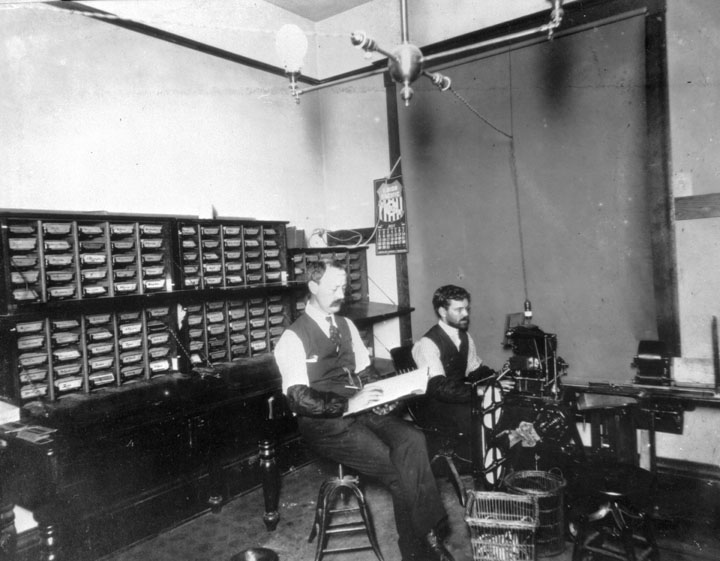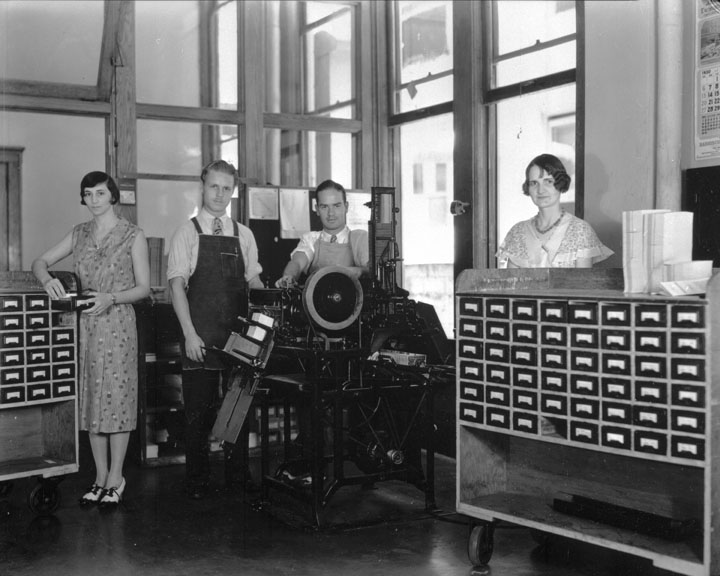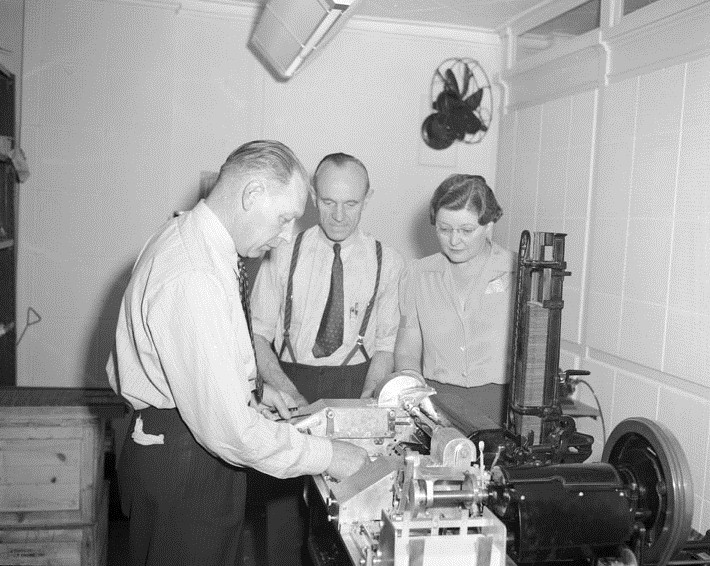The Addressograph Section
 |
|
| (July 1906)* - Stencil Room - Jack E. White and R. E. Outcalt. |
September, 1930 - Overview of the Addressograph Section**
An index to the growth of Los Angeles is the change in totals of services. In 1906, for example, when Los Angeles barely had reached the 200,000 mark, there were slightly over 52,000 water services. At the close of the fiscal year last June, there were more than 315,000 water services and the population of the City now had brought this western metropolis to fifth place in the Nation.
Fourteen men and women work daily (and rapidly, too) turning out the required quantity of stencils for the addressograph work. This efficient staff is under the direction of Miss Florence Hannibal who, in turn, looks for responsibility to Franklin Roberts, in charge of the Commercial Bookkeeping Section.
IN 1906 – Things were different in 1906. The entire Addressograph Section occupied one average size office room. Two men, using foot-power machines, were able to transact all of the business of the Addressograph Section. The office contained not only the two men, one hidden safely under a heavy growth of black beard, the other supporting a black moustache worthy of a Trampas – but it housed the machines, two odd waste baskets, two swivel chairs, a brass cuspidor, a rack containing the stencils and a free calendar from the railroad company.
C. E. Outcalt, now manager of the San Pedro Commercial Office, was in charge of the Addressograph Section nearly a quarter of a century ago. His staff consisted of Jack White, now on the Reserve List of the Department.
In the old days bill collections were made from door to door. The collectors made their notations and checked against the stencils before they left each morning. Nowadays, all bills are mailed.
Coming down to the present, it is enlightening to note a few figures pertaining to the operation of the Addressograph Section which occupies almost half of the large room on the second floor of the Broadway building.
HOW IT’S DONE – The Addressograph Section embosses new installations, new contracts and closing bills for Los Angeles and all of the branch offices, Miss Hannibal explained. This work is being done by three Graphotype operators who complete approximately 480,000 stencils a year. The Graphotype machine must be seen to be appreciated. It is a large contrivance that should frighten most women out of their wits but those who sit all day and make the stencils are quite expert at their work.
Reading sheets on all new service installations, which become a meter reading record, are addressographed by this Section. These records are replaced every third year and average about 200,000 per year or 400,000 impressions.
Miss Hannibal said that ledger cards are addressographed, dated and numbered. The bill number is punched during the same operation by a specially designed and constructed machine developed by the Department of Water and Power. The number of ledger cards completed in the past fiscal year was considerably over six million.
The consumers’ bills are addressographed and dated by an automatic machine, the date being printed on the reverse side of the bill. Both impressions are made in one operation of the machine and during the past fiscal year 5,989,648 bills were printed.
One F-1 addressing machine is used in listing index cards for the addressograph record frames. Two F-2 addressing machines are used for the courtesy notices sent out each month to various consumers, reading sheets, field collection copies, closing bills, envelopes, statements and other miscellaneous forms.
Three small hand-operated machines are placed at strategic points to handle miscellaneous requests for stenciled forms. The machines do not require the use of power for their operation and permit a more rapid completion of small operations due to their accessibility. Approximately 3,500,000 miscellaneous forms are addressographed each year by this section.
The personnel of the addressograph section consists of the following besides Miss Hannibal: Emogene Downs, Delores Guizar, Mrs. Beulah Tobey, Mrs. Ruth Lee, Wilhelmina Postma, Mrs. Alice M. Watson, Julia Gurske, Clarence M. Matson, Samuel Munster and Elsie Shearer.
FAR CRY – It certainly is a far cry to the days of the beard and the moustachio – the days of Outcalt and White. We hear talk now and again of “those good old days.” They were all right if you like novelties, say the modern office workers.
Those who had a gay old time in the “old days” are among the snappy and efficient ones of today and glad of the chance to pitch in and help increase the Service to our Public.
If the outsider had any doubt of the activity of the modern Addressograph Section this doubt would quickly be dissipated by a visit to the Section where the wheels go around, the stencils clatter, everything moves with workmanlike precision so that the countless tasks which fall to the lost of the Addressograph may be completed in the required time and with the ultimate degree of satisfaction to all concerned.
NIGHT WORK – After the noises of the day have died down and Miss Hannibal’s staff “clears out” for the day that is, not the end of the story by any manner of means.
Miss Hannibal assures us that is only about the half of it. A night crew comes into the picture and prepares the postings down to the last minute so that when the wheels begin turning in the morning, thus taking up the slack of the midnight hours and then – as our movie title writers used to say:
Came the Dawn!
 |
|
| (1930)* - Addressograph Section - pictured are: Julia Gurske, Clarence M. Matson, Samuel Munster and Elsi Shearer. The Addressograph Section embosses new installations, new contracts and closing bills for Los Angeles and all of the branch offices. |
 |
|
| (1941)* - Shown grouped about a new attachment for an automatic fee addressograph machine are (left to right) Frank Tennant, who designed the device; Christian E. Jensen, maintenance man for Commercial Division addressographing machines; and Florence Hannibal, supervisor of the Addressographing unit. |
LADWP Historic Archive
August 1941 – Elimination of an operation on tabulating cards formerly performed on a different type of machine, by another division, is the achievement of an attachment recently installed on one of addressograph machines of the Commercial Division.
Believed to be the only device of its kind in the entire United States, it was designed by Frank Tennant, from suggestions made by Commercial Division employees. It was fabricated in the machine shop at 1630 North Main Street where Mr. Tennant is a foreman. The attachment enables the addressograph machine to perform more operations faster, more efficiently and more quietly, it was stated by Homer White, commercial director.
Tabulating cards formerly were progressed through a slower addressing machine which printed on each card the date, consumer address and bill number and also punched in the bill number.
With the new attachment installed on an automatic feed type addressing machine, not only are all the above mentioned operations performed, but in addition, the machine also “gang” punches the meter book number, serial number and debit symbol as the cards pass through the machine. This eliminates one complete operation formerly done by the Tabulating section of the Accounting Division. Production has been stepped up to approximately 5,000 cards per hour, compared with a rate of less then 4,000 cards by the old method.**
References and Credits
* DWP - LA Public Library Image Archive
< Back
Menu
- Home
- Mission
- Museum
- Mulholland Service Award
- Major Efforts
- Board Officers and Directors
- Positions on Owens Valley and the City of Los Angeles Issues
- Legislative Positions on
Water Issues
- Legislative Positions on
Energy Issues
- Recent Newsletters
- Historical Op Ed Pieces
- Membership
- Contact Us
- Search Index